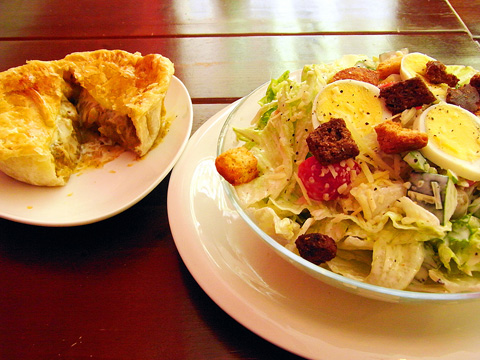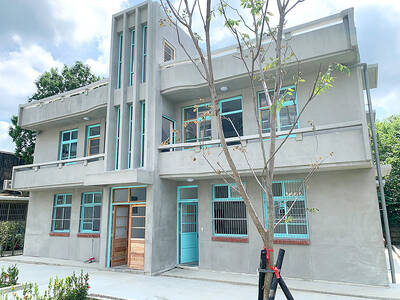This is the third week in a row that pies have featured in the Taipei Times’ restaurant review section. Too much of a good thing? Given that prior to March there was a dearth of decent, tasty handmade Western-style pies sold at reasonable prices, perhaps not.
The latest offering is Pie Boy, tucked in an alley off Zhongxiao East Road. The small restaurant is an intimate affair, with Venetian red walls, black wood paneling, two four-seater tables and one two-seater table inside, and a two-seat table on the narrow deck outside. Paper cutouts of two tiki, Maori symbols, and a New Zealand fern leaf adorn the back wall.
David Bernhartt, who was born in the UK but grew up in New Zealand, opened Pie Boy on March 15 as an alternative to the ubiquitous burgers and pasta served in typical ersatz Western joints. The menu is reassuringly simple: steak and cheese (NT$95), chicken and vegetable (NT$90), mince beef (NT$90), vegetarian (mushroom, broccoli and cheese, NT$90) and breakfast pie (NT$90).

PHOTO: STEVE PRICE, TAIPEI TIMES
The pies’ bases and sides are made of shortcrust pastry and flaky pastry is used for the tops, which provides a subtle combination of textures. Combos are available. But be warned: the steak and cheese pie and wedges (NT$135), which are hand cut and sprinkled with a piquant seasoning and served with either aioli or salsa, is a belly-busting meal deal.
Although a far cry from the purist’s version, Pie Boy’s Caesar salad (NT$100), which uses iceberg lettuce, three slices of boiled egg, green olives, cherry tomatoes, onion, croutons, green pepper, cucumber and grated Parmesan, is a meal in itself and can be ordered with a pie in a combo deal (add NT$70 to the pie’s price for a salad and drink). Compared to Subway’s vegetable salad, which costs NT$95 plus NT$10 for dressing, Pie Boy’s salad comes out on top for value and taste, especially as the fast-food chain recently reduced the amount of processed cheese slices it uses.
The breakfast pie, essentially an omelet in a pastry shell, is a drier alternative to the gravy-filled versions and is, therefore, easier to cut into segments and transport. The vegetables used in the filling — green pepper, onion and tomato — are crunchy and contrast nicely with the velvety texture of the cooked egg.
To get there from the junction of Zhongxiao East and Fuxing South roads, walk westward along the north side of Zhongxiao East Road and turn right at the first traffic lights. Pie Boy is two blocks up the alley on the right. —STEVE PRICE

June 2 to June 8 Taiwan’s woodcutters believe that if they see even one speck of red in their cooked rice, no matter how small, an accident is going to happen. Peng Chin-tian (彭錦田) swears that this has proven to be true at every stop during his decades-long career in the logging industry. Along with mining, timber harvesting was once considered the most dangerous profession in Taiwan. Not only were mishaps common during all stages of processing, it was difficult to transport the injured to get medical treatment. Many died during the arduous journey. Peng recounts some of his accidents in

“Why does Taiwan identity decline?”a group of researchers lead by University of Nevada political scientist Austin Wang (王宏恩) asked in a recent paper. After all, it is not difficult to explain the rise in Taiwanese identity after the early 1990s. But no model predicted its decline during the 2016-2018 period, they say. After testing various alternative explanations, Wang et al argue that the fall-off in Taiwanese identity during that period is related to voter hedging based on the performance of the Democratic Progressive Party (DPP). Since the DPP is perceived as the guardian of Taiwan identity, when it performs well,

A short walk beneath the dense Amazon canopy, the forest abruptly opens up. Fallen logs are rotting, the trees grow sparser and the temperature rises in places sunlight hits the ground. This is what 24 years of severe drought looks like in the world’s largest rainforest. But this patch of degraded forest, about the size of a soccer field, is a scientific experiment. Launched in 2000 by Brazilian and British scientists, Esecaflor — short for “Forest Drought Study Project” in Portuguese — set out to simulate a future in which the changing climate could deplete the Amazon of rainfall. It is

The Taiwan People’s Party (TPP) on May 18 held a rally in Taichung to mark the anniversary of President William Lai’s (賴清德) inauguration on May 20. The title of the rally could be loosely translated to “May 18 recall fraudulent goods” (518退貨ㄌㄨㄚˋ!). Unlike in English, where the terms are the same, “recall” (退貨) in this context refers to product recalls due to damaged, defective or fraudulent merchandise, not the political recalls (罷免) currently dominating the headlines. I attended the rally to determine if the impression was correct that the TPP under party Chairman Huang Kuo-Chang (黃國昌) had little of a